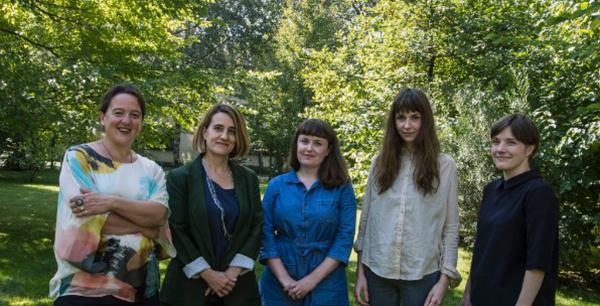The Whitechapel Gallery, Collezione Maramotti and Max Mara revealed the names of the five artists shortlisted for the sixth Max Mara Art Prize for Women at a special event at the historical headquarters of Max Mara in Reggio Emilia, Italy on 4 October 2015. The shortlisted artists are Ruth Ewan, Ana Genovés, Emma Hart, Tania Kovats and Phoebe Unwin.
The shortlist, featuring installation artists, sculptors and a painter were selected by a judging panel chaired by Iwona Blazwick OBE, Director of the Whitechapel Gallery, joined by Fiona Bradley, Director of the Fruitmarket Gallery, Edinburgh; Sarah Elson, Collector and Founder of Launch Pad, a commissioning series supporting emerging artists; Helen Sumpter, Critic and Senior Editor / Web Editor at ArtReview; and Artist and Royal Academician Alison Wilding.
The Max Mara Art Prize for Women was established by the Whitechapel Gallery in collaboration with the Max Mara Fashion Group in 2005. Its aim is to promote and support UK-based female artists who have not previously had a solo survey exhibition, making it the only visual art prize of its kind the UK. The winning artist, announced in early 2016, is awarded a bespoke six-month artist residency in locations around Italy after presenting the judges with a proposal for a new body of work. In 2017, work by the winning artist is shown in a major solo exhibition at the Whitechapel Gallery before touring to Collezione Maramotti in Italy.
The shortlisted artists for the Max Mara Art Prize for Women 2015-17 are:
Ruth Ewan (b. 1980, Aberdeen)
Ewan’s practice covers installations, printed matter and events. Her interests lie in radical, political and utopian histories, which she draws on through close research and collaboration with diverse groups – from historians, archaeologists and horticulturalists to musicians, magicians and bakers. In her 2015 exhibition Back to the Fields at Camden Arts Centre in London, she created a real life visualisation of the ‘French Republican Calendar’, in a major installation including flora and fauna, live animals and a full-scale otter’s holt. Following the French Revolution, the calendar was developed by French artists and the state, and renamed days and months after elements of the natural world in an attempt to rid France of religious and royalist influences.
Ana Genovés (b. 1969, Madrid)
Genovés uses photographs of public constructions, obstacles and facilities gathered online, offline and from her travels as reference points for her work. Particularly interested in overlooked or overused objects and spaces – from bollards, mini-golf courses and roadside shrines to communal washrooms, military watchtowers and other indiscernible utilitarian forms – she replicates them in works highlighting the uncertain nature of the neat geometry of the world around us. Her recent exhibition at Standpoint Gallery, London featured a selection of site-specific works including Concrete stage and partition wall (2014) which made use of the architectural peculiarities of the gallery – from the raised floor of a former office to the false walls – to provoke an ambiguous relationship between the viewer, the piece and the space itself.
Emma Hart (b. 1974, London)
Hart works across ceramics, video, photography and sound. She is concerned with the way real experiences are misrepresented when captured on camera, and channels her anxieties, embarrassments and autobiography into her work. She sets photographs and video screens against crude clay shapes, or scales-up ceramics in detailed installations that saturate the senses. Giving It All That (2014), her recent work for the Folkestone Triennial, was installed in a disused flat and aimed to put the viewer under different social pressures. In a space marked with spillages and sweat, long pink limbs offered clay drinking vessels from serving trays decorated with lurid photographs, while mirrored eyes peering over ceramic clipboards monitored the room.
Tania Kovats (b. 1966, Brighton)
Kovats produces sculptures, large-scale installations and time-based works exploring our relationship to and understanding of the landscape. Renowned for her large-scale works in the public realm, she produced the Natural History Museum’s first permanent art installation, Tree, in 2009. Marking 200 years since Charles Darwin’s birth, the commission was inspired by a simple diagram made in his notebook following his voyage on the Beagle. In her recent work Rivers (2012), installed in the grounds of Jupiter Artland Sculpture Park in Scotland, Kovats collected water from one hundred rivers around the British Isles and housed the bottled vials in a specially constructed boathouse.
Phoebe Unwin (b. 1979, Cambridge)
Unwin is a painter who experiments with a range of materials including Indian ink, spray paint, acrylic and oils. Rather than working from photographs, she often creates work from memory or sketchbooks that act as visual notebooks of her day-to-day experiences. Combining abstract washes of colour, elements of portraiture and minimal still lives, her works include Aeroplane Meal (2008), which depicts the recognisable form of a plastic food tray rendered flat in spray-painted shapes, set against a layered background reminiscent of a patterned carpet or a landscape viewed from above.
Photo: Gabriele Micalizzi / Cesura. Courtesy Collezione Maramotti

